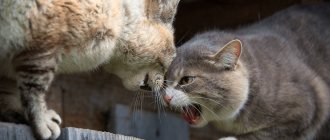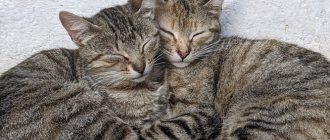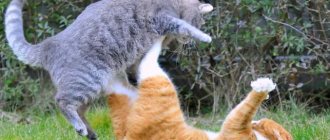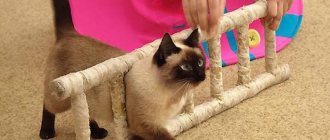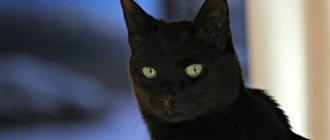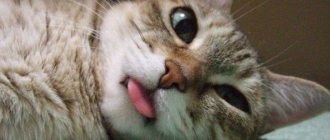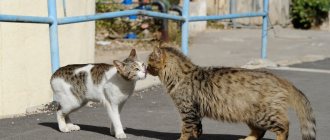Cats have a number of different ways to express their mood and react to what is happening, which can be expressed through facial expressions, behavior and body movements. Scientists have found that sign language includes about fifty movements of the head, tail and ears. Everyone knows how an animal behaves when expressing its unfriendly attitude: its back arches, its fur stands on end. Thus, it tries to look more impressive in the eyes of the enemy.
Communication like a cat
Either Masonic lodges, or public meetings of cats... Everywhere where they live, there are separate areas that none of them divides or considers their territory. This is their “common land”, where they gather in large numbers from time to time. At the same time, local cats, sitting peacefully, sit silently or calmly walk around, looking at each other. The meaning of these meetings is completely inexplicable. Maybe these are social gatherings where they communicate telepathically? Until now this remains an unclear issue.
Touch is one way to communicate. Cats need this if they rub their noses or sit close to each other, show care for their relatives, all this serves to establish connections and communication. With the tenderness and softness inherent only in cats, they also touch us humans. This behavior shows satisfaction and affection and, in addition, it helps to strengthen the bonds that occupy such an important place in their lives.
In general, cats are very “talkative” animals. And each with its own, individual voice, which both friends and enemies will recognize. They use it to communicate with both relatives and people. In “conversations,” a cat is able to produce about forty different sounds, including about nineteen variations of “meow.” You can also hear something similar to the “chirping” that a cat makes when it is busy tracking down a bird; it may well be that this is a way to lure or lull the vigilance of its prey.
I wonder if cats read your mind?
How do they understand you when you say, “I need to take my cat to the vet today?” Many veterinarians and psychologists who study cat behavior believe that they understand us quite well telepathically. So many people are often forced to postpone visiting the doctor because their pet simply disappears.
Cats communicating with each other
Which dog breeds are often confused with each other?
How cats communicate with each other can be seen in stray animals. They form flocks around places where there is food. Often their colonies can be seen near shops, landfills, and veterinary clinics. Flocks have their own hierarchy; the cats' conversation boils down to caring for each other, caring for other people's kittens, and communicating with each other.
In scientific circles, it is generally accepted that cats do not communicate with each other through meowing. When communicating with each other, they use body language, facial expressions, and hissing. They may even greet fellow higher ranks by nodding their heads when they meet.
Colony of stray cats
With kittens, cat conversation comes down to “purring.” While licking each other, the cats purr with pleasure, showing with all their appearance how much they enjoy this procedure.
Eyes
You can tell your pet's mood by the eyes. In a tired or irritated animal, the half-closed eyes narrow, turning into slits. Having seen a pet with such eyes, the owner must conclude that at the moment the cat is most likely not very inclined to communicate. If a cat is in a great mood, she will look at her owner with wide, rounded eyes. Her movements will be relaxed, and she will probably eagerly respond to an offer to play and frolic. If a pet looks into the owner’s face with a gentle, somewhat ingratiating look, we can conclude that he wanted to beg for something tasty. Like other representatives of the fauna, cats prefer to avoid long looks directly into the eyes. It is characteristic that if one of two animals living in close proximity has, so to speak, a higher status, then its gaze is usually a deterrent.
Gaze also plays a significant role in the relationships between males. If there is a confrontation between the cats and they come together to find out who will keep the territory, then to express aggression the rivals will look into each other’s eyes with hostility. In addition, the gaze can have a strong impact during the hunt. A victim who keeps his eyes on the cat may cause it to become somewhat confused, resulting in the pursuit ending in failure.
A cat has a remarkable ability to appear completely disinterested, but at the same time the animal vigilantly observes everything that is happening next to it. By the tense posture and the tips of the ears slightly tilted forward, you can determine that the animal is currently closely watching the enemy or the victim.
09.08.2019
Cats, as you know, are predominantly solitary animals, and not pack animals like dogs.
Cats communicate with each other mainly through body language and smells.
It was impossible to establish contact with a person in such ways, since a weak sense of smell allowed him to distinguish only strong aromas, and people still have not learned to correctly understand a variety of cat gestures - from a wriggling tail to moving ears. Otherwise we wouldn't get so many scratches.
So, in the process of domestication, cats had to establish a new channel of communication with people - smart little predators learned to meow and purr in a special way, since humans hear well, including at the frequencies of cat vocalizations.
Interestingly, wild felines can also meow, growl and purr, with growls and purrs rarely occurring in the same species. The reason for this is still not entirely clear. However, the cats themselves use this entire sound set freely and in a very varied way.
Most likely, having settled next to people, cats tried different ways to get tasty food or simply the attention of two-legged animals, until they found a vocal option that works most effectively.
Meow
While studying the feral cats of Jirisan National Park, South Korean biologists discovered that when alone, they are mostly silent. But if they encounter a person, dog or other potential danger, they growl, howl and demonstrate a repertoire even wider than that of domestic cats.
An important feature of the “language” of wild animals turned out to be the absence of meowing in response to human actions - behavior that is very characteristic of domestic cats. Apparently, meowing in communication with people can have many meanings
Tail
The cat's tail plays a special communicative role: it is used as a simulator and teaching aid for the mother cat when training kittens; can tell others about the animal’s intention to retreat; about a good or, conversely, bad mood. A tail wrapped around the body indicates a good-natured mood. If the tip moves slightly, it means the cat is curious. Excessive movement of the tip of the tail can signal either irritation or an aggressive attitude. Everyone knows how an animal reacts when its tail is pulled. After this, it will treat its owner with distrust and is unlikely to become a devoted friend. The exception is when small children play with a cat. The pet will courageously endure this not very pleasant procedure or simply try to leave the premises.
Translator from cat to... Japanese
There are so many mobile applications that translate the language of these animals right now! You can download a special program that will help you communicate with your pet. The first to create such a multifunctional translator, albeit a computer one, were the Japanese.
In 2003, the Japanese announced the beginning of the era of human-cat communication by releasing a translator - a special device equipped with an LCD screen and a microphone. It is so small that it can fit in the palm of your hand. This device is called “Meowlingual”.
The gadget is able to recognize the purring of 14 of the most popular cat breeds. Having received the sound, it converts it into one of the 200 Japanese phrases available in the database. The translation is immediately displayed on the device screen. To type basic words, experts from the National Institute of Acoustics, who developed the device, used various types of purrs from American and Siberian shorthair cats. The gadget is able to determine the animal’s mood - indifference, satisfaction, fear, irritation, etc. In addition, it is also equipped with a dictionary, which includes about 3 thousand words.
With this device, cat owners can easily determine what their pets want to tell them. For example, if an animal meows briefly, it means that it wants to eat, and will decipher a similar sound signal as “Meowling.”
Hearing and voice
Hearing and voice are also a means of communication. As already noted, cats have excellent, finely organized hearing and can perceive a very high range of sounds and tones. In addition, nature has endowed these animals with excellent modulation data. Thanks to the synthesis of these two qualities, cats have a wide range of articulatory and acoustic capabilities. Experienced owners are excellent at recognizing changes in the mood of their pets by the timbre of their voice.
So, a cat, as a rule, has its own specific means of communication. Here are some of the main features inherent in the language of cats:
- a short sound symbolizes goodwill and joy from the meeting;
- a cat is able to give its voice both a demanding and ingratiating tone;
- piercing loud screams, as if escaping from the throat, are an expression of complaint (as a rule, such sounds are made by an animal locked in solitude for a long time);
- With these same guttural cries, the cat signals hunger;
- an unfairly offended cat expresses its feelings in a choked voice;
- plaintive moaning, reminiscent of loud crying, is an expression of pain, poor health, a request for help (for example, a cat screams when it climbs to the top of a tree or gets caught in a narrow pipe);
- the pet makes a cooing purr during petting, expressing sympathy for the mating partner and the mother’s affection for the cubs;
- calling her babies, the cat makes melodious sounds that caress the ears;
- at critical moments, when the animal experiences fear mixed with aggression and seeks to intimidate the enemy, it makes sounds of changing tonality;
- Frightening deafening screams are heard during the mating season, as well as during meetings and battles with the enemy.
Purring most often expresses the good mood that a cat experiences when it is warming up on a soft sofa and preparing to take a nap. And if the pet sees that they are going to give it something tasty, then the purring can develop into piercing screams. Cats make their first purr almost in the very first hours after birth, when they attach themselves to the mother's nipple. However, the animal can also express negative moods with the same sound. For example, if a cat begins to be stroked against the grain, it will most likely not be slow to express its protest with a quiet but decisive purr. The same sound is also characteristic of animals suffering from some serious illness, and even of those who are near death.
Felinologists suggest that cats begin to purr at moments when they feel better.
How to get a girl's cat to like you?
Here are some tips for this:
- Don't look the cat in the eye. And don’t approach her as soon as you’re in the house. ...
- Don't tower over the cat. Drop your shoulders and place your hands on your knees or sit on the floor. ...
- Do not make noise. Speak quietly. ...
- Don't extend your hand abruptly.
Interesting materials:
How to change currency in Ozone? How to change the language to English in the Taobao application? How to change the language to Russian in the Taobao application? How to change a user in Sberbank Online? How to change currency at Sberbank? How to change the language to Russian in Taobao? How to change currency in the Privat terminal? How to replace a non-breaking space with a regular space in Word? How to replace all Enters with spaces in Word? How to return or change a ticket in victory?
What cats talk about
There are people who find talkative cats annoying. A California breeder complained that with age he wanted peace, and Siamese cats began to bother him with their increased activity and talkativeness. He began to like ragdolls more, as they were calmer and more silent. But there are few such people.
Basically, owners are not at all annoyed by their pets, they talk to them and always understand their answers and desires. Not only in the nursery, but also in an ordinary home, people enjoy communicating with their four-legged friends. And then harmony and mutual respect reign there.
You don’t have to be a great expert to understand in each specific case what the cat wants, to listen to what sounds it makes. The next time you hear such a signal, you can determine what happened.
For example, you can unmistakably recognize the unimaginable cry of a cat that is in great pain. Even a small kitten in trouble makes similar sounds, as if calling on its mother to free it.
Sometimes cats disputing ownership can start a fight, causing a terrible noise. Often such cries are mistaken for mating games, but this is not always the case. The real “ cat concert ” begins when males are attracted by the smell of a cat during heat and gather from all over the area. The proximity of other cats makes them nervous, and they begin to vent their feelings by screaming.
In a situation where a cat is scared, it can simply run away silently, but if there is nowhere to run, a guttural sound, almost a howl, speaks of its fear. At the same time, in defense, she can become aggressive, she can “hiss” and “snort”. This behavior can be intimidating even to a large dog.
The most familiar meow a cat makes is, of course, one asking for attention. Little kittens make such sounds as soon as they are born. In wild cats that have grown up, this call disappears, and domestic cats begin to “talk” to their owners in this way. At the same time, they are able to adapt the voice to each situation in such a way that the owner knows about her specific desire.
Cats may have “meows” that are not annoying, simply indicating the desire to go for a walk. But the voice will sound completely different if it’s raining heavily and she asks to go back. There may also be “meows” that are demanding and pleading, restless and complaining, irritable, and also impatient, especially when opening a can of food. Inviting the kids to follow her, the mother cat makes a soft sound, a little like chirping. She can also use it if she really misses her owner.
But the most pleasant thing for owners is, of course, the cat's purring . It seems that the cat wants to say: “I’m happy with everything, I’m so good, flexible and harmless!”
Having lived together for many years, owners and cats understand each other perfectly, they feel good together. And how depressing the silence is in a house where there is no “talking” cat, therefore, in order for your cat to be cheerful and talkative, love her and communicate with her!
The language of cats (calls), or how to understand a cat
Cats can make sounds by moving air from their lungs through their vocal cords, just like humans. In order to give a certain shape to these sounds, you need to use the tip of the tongue, and cats do not know how to do this. However, they produce quite a lot of vowel and consonant sounds due to the tension of the muscles of the throat, mouth and lips.
Cats make calls that a person begins to understand when living with the animal. It would seem strange, the cat says nothing except “meow”, how can she control a person and get what she wants?
How do cats communicate with people?
It turns out that cats' communication is based on changes in sound intonations, which are changed by slowly closing their mouths. For example, when pronouncing “meow,” the vowel part is “a-o-u,” and the “a” sound is made when the jaws are open. And we hear the sounds “oh, uh” when the jaws are closed.
Man has studied and understands the calls of cats, at least five of them.
Requirement
When a cat begins to demand something, it makes sounds that, when inhaling, begin like an ingratiating and cajoling purr. And they end on exhalation with a set of vowel sounds. It turns out something like “m-r-r-n-a-a-a-a-o-u”, with the emphasis being on the drawn-out connective “a-a-a-a”. The emphasis on this link is even greater; if the demand intensifies, the sound “r” gradually turns into “i”, ending as an extended “meow”.
If you don't pay attention to the cat, the urgency of its call changes. Her expectations have not come true, her calls become hopeless, weak, and sound of bewilderment. Protesting against this injustice, she relieves tension from the ligament “a-a-a-a”, transfers it to the sounds “o” and “u”, they become more drawn-out.
Pleading Demand
If a cat sees a goal that it definitely wants to achieve, this could be its favorite toy or the dish that it likes the most, then it seems like it wants to tell you: “Well, give me this, please!” All her attention is concentrated on this object of adoration, and she uses approximately the same call as the first, but with an emphasis on “o” and “u”. It is pronounced with a slow closing of the mouth, and the result is an even more prolonged “m-r-r-r-n-n-a-a-a-a-o-o-o-u-u-u”.
Complaining call
A cat can complain in different ways, since the reasons are different. If you suddenly hear a plaintive, weak call that sounds sad and reproachful: “Eh, you, but I thought that I meant something to you, and you love me!” This sound is made during the swallowing movement and sounds “m-m-n-g-a-a-o-u”, it is accented on the last “u”.
But if a cat wants to convey a completely different emotional state, if it fights for its rights with its owner or another cat, then it wants to express something like this: “How can you do this to me!” In this case, in the same call the sound “a-a” is drawn out, meaning a grumbling signal.
Puzzled call
When a cat asks for something familiar, something that goes without saying, it is convinced that its request will definitely be fulfilled. For example, before feeding, the cat waits for the result with confidence; she knows that she will now receive food. And suddenly the unexpected happens, you had to go to the phone or somewhere else, you didn’t have time to put the food in the bowl, then your cat could say the following: “Hey, answer me, what’s going on there?”
And she produces a signal expressing genuine indignation and bewilderment. Her “meow” first sounds loud and drawn-out “a-a”, and ends with a prolonged “u” sound with an intensification and rise in tone, which becomes dominant.
Concerned Call
So, the cat didn’t get what she wanted, her tactics change. The puzzled call turns to concerned. Her dissatisfaction and anxiety are expressed by the fact that she shortens her drawn-out “a-a”, it becomes more like the English short sound “e”, as in the word “cat” - cat. “Not getting” what you wanted results in a concerned and interested sound “m-a-e-o-u-u-u-u”, accompanied by peculiar body movements.
Other situations
There may be other situations for a cat to use different calls. Let's look at the most likely circumstances in which you may find yourself interacting with your animals.
In search of a reward, a cat may make frequent and loud calls. Perhaps she wants to receive something very tasty as a reward. And the more important and meaningful this award is for her, the more intense the call. It happens that it is not immediately clear what exactly she is asking for. Then, by placing dishes in front of her so that she cannot reach them, you can understand what the cat wants by the frequency and loudness of the call.
If a cat has been taught by experience that only a confident cry will help her cope with any task, then her call sounds with an emphasis on the first sounds “a-a”. Such calls reflect the degree of confidence that accompanies the cat's activity.
To “talk” with people, cats have special calls that require attention. They express the emotional state of the animal or a certain need.
Sometimes it is noticeable that the cat is not feeling well, perhaps she is sick or is affected by a change in weather. Your suspicions may be confirmed if, when addressing your pet in a gentle, sympathetic manner, she meows pitifully.
When you return home after a short absence and speak to your cat in a friendly, welcoming tone, you may hear a welcoming purr in response. Such sounds can only be heard by a family member whom the cat knows and loves, since purring is often intended for people rather than other cats.
Cat language: translator
• If a cat reaches out its paw to your face, then it is asking for affection and attention.
• Wide-open pupils indicate fear.
• When a cat stomps its paws, slightly releasing its claws, it means that it is very happy, adores you, and wants to do something nice.
• When a cat squints, it demonstrates calmness and peacefulness.
• Does your pet quickly lick its lips and nose? She's confused.
• Beats its tail - it means it is angry or hunting.
• Large eyes and pupils indicate that the cat is afraid, angry or playing.
• A trumpet tail is a sign of joy, a kind of greeting.
• If she moves the tip of her tail, it means she is interested in something.
• The cat stares at you - this is a challenge (usually to play tag).
• Quick licking of the front paw is a sign of excitement.
• A tail frozen at the bottom indicates disgust or disappointment.
• The fact that a cat rubs its head against a person speaks of love, devotion and thirst for affection.
• Strong tail swings in different directions are a sign of irritation, small waving indicates curiosity and excitement.
• If the ears are pressed to the head, then the pet is preparing to attack. If at this time the cat makes circles with its tail, it means that it is irritated.
• The fact that the pet is interested in something or is ready for action is indicated by the fact that the whiskers are directed forward.
• Sign of curiosity - ears upright.
• If the cat looked around and then began to lick itself thoroughly, this indicates complete or feigned (during play) calm.
• The tail is raised vertically, the tip is relaxed - a sign of joyful excitement.
• If a cat is pressed to the floor, then it is either hiding or preparing to attack.
• The fact that your pet is rubbing against your legs means that it is marking you. Purrs have scent glands on their faces. All her relatives should smell “their” scent.
• A cat's meow is a greeting or a request.
• This cat's behavior indicates a warning: the eyes are large, the ears are back.
• If a cat scratches its claws loudly, then it wants to be paid attention to. • Is your mustache down? This means that the pet is worried about something, is sad, or is sick. • Is your mustache down? This means that the pet is worried about something, is sad, or is sick.
• Is your mustache down? This means that the pet is worried about something, is sad, or is sick.
• Does the cat lift its tail and turn its back towards the owner's face? Know that this is a greeting gesture between cats (the dominant one sniffs first). Also, such behavior is a sign of respect and trust.
• A cat's purring indicates calmness.
• Rumbling indicates dissatisfaction.
• If you hear a short cry, then the cat is scared of something.
• Intermittent meowing is a response to human contact.
• Is the cat rolling around on the floor? Know: this is how she demonstrates her attractiveness.
• Howling indicates that the cat is angry.
• Fully extended paws indicate self-confidence, while bent paws, on the contrary, indicate uncertainty and timidity.
• Hissing is a sign of readiness to fight, a kind of warning to your opponent.
• Muffled purring, which ends with a dissatisfied rumble, is a sign that patience has run out.
• A pressed, bunched mustache speaks of concern and anxiety.
• If a cat arches its back and grumbles, then know that in this way it scares its opponent, and also shows irritation and readiness to defend itself.
• The restrained purring of a nursing pet is a warning to babies from possible danger. If the purring ends in a raised tone, then she warns people or other creatures not to approach the kittens.
• When a cat is relaxed and calm, its whiskers hang down on the sides of its face.
• If an animal runs away from you at a fast pace, with its head drawn in, then it means it has done something bad.
• When a cat hides its head in a corner, it is hiding like this.
• Displeased purring is a sign that something is bothering your pet.
• Is the cat sitting with its paws tucked in, its tail turned around? Know that she is simply observing.
• If your pet dances, lifting her front paws off the floor, then know that she is greeting someone she loves.
Purring of cats - types of purring
Perhaps the most expressive animal in showing its feelings is the cat. She has many ways to show her mood, attitude towards the people and animals around her. One of them, the most pleasant for humans, is purring (rumbling).
Why do cats purr (purr)?
This sound has such a beneficial and calming effect on both kittens and humans. Today, the most common belief about this is that the cat’s larynx contains “ false vocal cords ” - two folds on the mucous membrane of the lower part of the larynx. Due to them we hear such a characteristic sound.
The owners believe that if a cat purrs, it means she is happy and happy with everything. Most often, this is true; purring is a sign of an excellent mood in a cat. However, in some situations this view may be incorrect.
Listen, and you will understand that this explanation of the purring of a cat, to which everyone is accustomed, does not take into account the nuances of sounds, and they say a lot. Perhaps only the owner will be able to distinguish in the rumbling of his pet not just one sound, but a plexus of several sounds, varying in intensity and frequency. And they reflect not only the cat’s pleasure, but the entire range of feelings, although they are expressed by seemingly insignificant, subtle changes in the rumbling.
Rough rumbling
The distinct sounds of each beat of a “rough” purr signify the achievement of the pet’s highest pleasure. She seems to be trying to clearly express such thoughts: “Please don’t stop making me feel so good, I love you, I love you so much!”
Soft rumbling
But now the cat has calmed down, begins to doze off, clear beats of purring can no longer be distinguished, it softens, becomes more gentle. Such sounds seem to convey that you can stop, that everything was just wonderful, they express something like this: “You guessed it, that’s what I needed, and it was great!”
Soft rumbling on high notes
If the cat wants to get even more attention or something that gives even higher pleasure, then this is indicated by another type of soft purring - at high notes. As if a new sound is being added from somewhere in the chest, a high-frequency “r-r-r”.
It can be used to judge that the animal is in anticipation of something especially good, your new caresses, food, favorite games. With a soft purr with the addition of high notes, she seems to be telling you: “Yes, I should get exactly what I want!”
Pleasant purr
When a cat really wants something, it tries to appease you, and this is expressed in certain sounds. These are sounds using the grating “r”, all together they sound like “m-r-r-r-a-o-u”, and the translation of this ingratiating signal is: “Well, I beg you, do it, please!”
Appreciative purr
Your cat already has her favorite toy, her favorite treat, waiting for her, she understands this and wants to express her recognition. Such purring can refer not only to the owner, but sometimes to another animal, and the translation means: “Thank you!” And it sounds something like this: “mmnngg.” That is, when inhaling, a short and fast rumbling sound is produced, at the same time the pitch decreases and ends with the nasal consonant “ng”.
Restless rumbling
It remains mysterious and incomprehensible why cats use the same signal to convey a joyful state and despair. It happens that a cat purrs not only from pleasure, but also when seriously unwell, when pain occurs.
If a pet at home is sick, they have already begun to treat it and soon it begins to purr, then this can mislead the owner. He may think that the cat is getting better, but she may have gotten worse. Therefore, during or after an illness, if your pet begins to purr for no apparent reason, then be sure to consult a doctor.
Welcome purr
You come home, and the cat runs towards you, trying to express its friendly “Hello!” It produces the sounds “mr-mr-mr-mr”, which look like a mono sound made when inhaling, but, in fact, it is a combination of the original sound “m” with an aspirated “r”, similar to what was described in the section "Soft rumbling on high notes."
While the cat is running to meet you, she can utter a whole series of such greetings, using as a subsound the rolling sound “r” (it turns out “m-r-r-r”), which is added when the cat experiences special joy at a meeting or at jumping onto a favorite but forbidden place - the bed.
Call sign purr
The meaning of the call sign purr means “come here” and resembles a greeting. Starting to pronounce it with the nasal sound “x”, the cat makes a swallowing movement, its mouth is tense and it says: “hmm-hmm-hmm”. When the vocal cords are quickly closed, the cat catches the exhaled air, hence the swallowing movement. Depending on who the cat is addressing, the signal can sound either as a gentle request or as an impatient command.
Cat calls - types of sounds made
One of the groups of sounds that cats can make is screams. Such loud and unpleasant sounds can mainly be heard during mating. And also during fights, when the “cat concert” is an expression of mutual threats. When producing such sounds, the jaws open wide and the muscles of the vocal cords tense.
Cry of refusal
It may be necessary to use a leash for your cat. And if you try to put a collar on her for this, you may hear the cry of refusal for the first time. She protests, she does not like attacks on her freedom. She will also resist with all her might against everything that she considers unacceptable to herself. This cry is creaky, low, dissected, it consists of vowel sounds “oe”.
In Russian there is no equivalent to it at all, for Germans it sounds like “o” in any German word, for French it corresponds to the sound of the word “ef”, in French it sounds like “egg”. And the whole cry combines several such sounds; we hear it with oscillating notes of “oo-oo-oo-oh,” which are somewhat similar to the sound of a car starting up when the battery is dead.
An angry cry
When cats reclaim their territory, they emit an angry cry. Such screams are so powerful that they resemble the roar of tigers in the jungle. Screaming at the top of their lungs, the cats bare their fangs, tilt their heads slightly, their evil gaze firmly fixed on the troublemaker. The cat’s mouth is open, from there, long, long sounds “VVVAAAAAOOOOOUUVVV” come from there, which are obtained by slow closing and opening the jaws.
At such moments, instinct comes first. Your adorable pet is so screaming and so protective of his corner of the garden that he can instantly turn into an unyielding killer. But at the same time, I will be very grateful if you intervene in such “stormy” negotiations and drive away the invader who is encroaching on someone else’s territory. Since you are your cat's leader, he will express his gratitude for saving your common property by licking you with his tongue, as if saying: “Thank you, thank you!”
Hiss
Imagine that something frightened you, a cry may suddenly escape your lips: “Ah-ah-ah!” For a cat, the closest equivalent to such a human cry is a hiss. Cat hissing sounds come in a variety of forms, but when a cat is scared, it will involuntarily make a short, quick "pfft" sound. This occurs due to the fact that a mass of air is released through her compressed lips.
But if suddenly an unfamiliar cat was careless to enter your personal territory, then you will hear a completely conscious, purposeful and already familiar “chsh-chsh-chsh-chsh-chsh.” It is clear that this is a signal of aggression, since it is accompanied by exposed fangs, constricted pupils and ears pressed to the head.
If this hiss is examined by sound, then it is the average between “k”, “x”, “ch”, “sh”. The cat is so furious, like a bull beating its hooves on the ground. But he is by no means going to rush into an attack; it is rather a ritual signal of aggression with which the cat tries to scare the animal and avoid conflict.
Is it possible to teach a cat to speak like a human?
Anyone can learn the language of cats. To do this, you need to study the meaning of gestures, facial expressions and sounds made by the animal. For translation from cat language to human, such nuances as movements of the tail, limbs, ears, postures taken by the four-legged pet, and the expression of its face are important. By the tone of the meow, you can also determine what the pet is trying to convey to its beloved owner.
| Gestures | Values | |
| Tail | Waving the tip | Curiosity, irritation, sadness |
| Swinging up and down | Strong excitement | |
| Actively beats its tail on the floor | Anger, readiness to attack | |
| Rotational movements of the tip | Readiness for defense | |
| Raised high | Friendliness, joy | |
| Tucked between hind legs | Fright | |
| Down and disheveled | Danger | |
| Paws | Fumbling, marking time | Happiness, pleasure |
| Pull | Self confidence | |
| Flexion | timidity | |
| Ears | They are moving | Alertness |
| Pressed and pulled back | Playfulness | |
| Pressed and lowered on the sides | Aggression, fear | |
| Shaking nervously | Uncertainty, irritation | |
| Pose | Body pressed to the floor | Ready to attack |
| Rolling on the floor | Showing attractiveness | |
| Arching your back | Irritation, readiness to defend | |
| Sitting pose with folded paws | Relaxation | |
| Lying on your side |
The facial expressions of these animals are varied and very expressive. Unlike vocal signals, it is innate and can say a lot about the pet’s mood. Newborn kittens instinctively recognize the meaning of the expressions in the eyes, smiles and grins of their relatives. People need a special dictionary for this. What does a cat’s smile or grin mean:
- grin - study of smells;
- closed or slightly open mouth - calm;
- a closed or slightly open mouth with the tip of the tongue protruding (sometimes bitten) - bliss;
- lips raised in a grin, bare teeth - a threat, readiness to attack;
- yawning – complete relaxation;
- rapid licking of lips and nose - anxiety, confusion.
Vaska, voice!
Dictionary of cat sounds:
- quiet and soft - a great mood;
- loud uterine or strangled sounds - dissatisfaction, resentment;
- piercing - pain, request for help;
- very loud, sharp - readiness to attack, fear, anger.
Typically, cats express pain, aggression and fear with lower sounds, while positive emotions, on the contrary, with higher sounds. Detailed interpretation of sounds made by kittens or adult cats:
- purring - pleasure, calmness, the highest degree of pleasure;
- rumbling - dissatisfaction, warning;
- hissing - readiness to attack, irritation;
- howling - anger;
- short cry - fear;
- meowing - a greeting, a request (cats meow when they want to eat).
If there are other pets in the house, they must be isolated from the four-legged student during the learning process. Teaching should begin with simple food-related words, the most popular of which is “meat.” It can be easily reproduced by cats, because it is similar to their usual “meow”. Some owners who have successfully taught their pets human speech advise saying this word during or after eating. Others recommend repeating the “meat” for an hour and only then feeding the animal.

